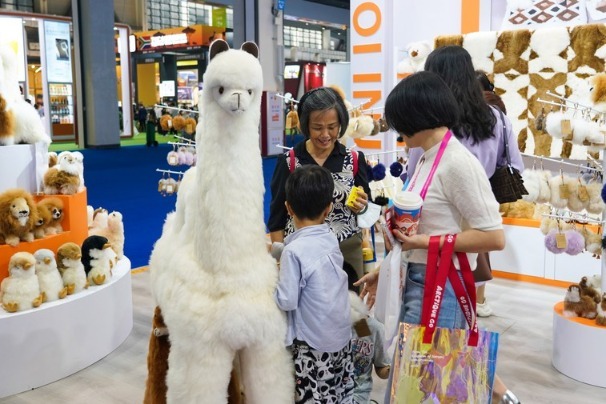Zones set to drive innovation into stratosphere

City districts home to tens of thousands of innovators and startups focused on AI and medicine
Beijing is ramping up efforts to build itself into a national science and technology center, with its major innovators playing a vital role.
The innovation hubs in Beijing-Zhongguancun Science City, Huairou Science City, Future Science City and the Beijing Economic-Technological Development Area, also known as Beijing ETown-have produced a slew of research achievements, injecting vitality into the growth of the local economy.
Zhongguancun Science City is home to more than 10,000 high-tech businesses including electronics manufacturer Lenovo and internet company Baidu, as well as scores of research centers and higher education institutions. Mainly located in Beijing's Haidian district, it has established a reputation as an epicenter of innovation nationwide, focusing on core technologies and pushing the frontiers of science.
An innovation-friendly ecosystem has been created in the science city, where a new urban management model has taken shape, according to the Beijing Science and Technology Commission.
Local authorities have issued a series of supportive policies to encourage innovation, especially in emerging sectors including artificial intelligence, intelligent connected vehicles and financial technology.
Leveraging its rich resources in the AI sector, the science city is advancing an urban brain program. Initiated in 2018, it aims to improve urban management and help enhance reform and innovation in a city's administration. To date, the program has attracted more than 60 high-tech businesses from various sectors featuring digital technologies. These include AI, big data, chips and integrated circuits, and equipment related to the internet of things.
At a 1,800-square-meter urban brain experience center in the science city, visitors can learn about the latest progress in the program. It covers a variety of smart scenarios, such as city administration, public safety, environmental protection, medical services and urban transport.
As well, a 31.85-square-kilometer science and technology innovation section of the China (Beijing) Pilot Free Trade Zone was revealed in the north of the city in late September.
It is designed to attract industry leaders and research facilities involving strategic emerging sectors of new-generation IT, biopharmaceuticals, IC, new materials, space economy and autonomous driving.
The construction of Huairou Science City is in full swing. The science city is advancing the construction of 29 scientific research facilities, providing key support for Beijing's drive to develop into an international sci-tech center while fostering legions of researchers for national strategic technological fields.
Of five major research facilities in the science city, one for a comprehensive extreme condition experimental apparatus has just been completed and entered the phase of equipment installation.
Meanwhile, the construction of an Earth system science numerical simulator facility has also been completed and 95 percent of its research equipment has been ordered. The main structure of a high-energy photon source facility has taken shape.
Huairou Science City will revolve around research into physical sciences, information and intelligence, space sciences, life sciences and the Earth system. Its framework is scheduled to take basic shape in 2025, said Yu Qingfeng, head of Huairou district.
"Through increased efforts in advancing the construction this year, we are striving to complete the goal one year ahead of schedule," Yu said.
In Changping district, Future Science City features two pillar industries of energy and life sciences, as well as a higher education park focused on academia-industry collaboration.
This science city, planned to cover 170 sq km, is home to a great number of State-owned enterprises, higher education institutions and corporate research and development centers.
The park will establish a research-oriented hospital dedicated to clinical research on new drugs that apply to enter the market, said an official from the district.
The new hospital will cooperate with the Yale Center for Clinical Investigation and Mayo Clinic in the United States, the official said.
He added that China's centers for drug evaluation, medical device evaluation, and food and drug inspection will extend support to the industries of pharmaceuticals and healthcare.
With four pillar sectors of new-generation IT; high-end autos and new energy vehicles; biopharmaceuticals and healthcare; and robots and equipment manufacturing, Beijing ETown plays a pivotal role in industrializing R&D achievements and upgrading the city's economic structure. It has been recognized as a national AI high-tech industrialization base.
During the first three quarters of 2020, Beijing ETown generated 317.91 billion yuan ($48.62 billion) in combined industrial output value, up 4.2 percent from the same period last year. Its GDP reached 135 billion yuan, up 4 percent year-on-year.
The industrial zone accounts for just 0.35 percent of Beijing's land. Yet it contributes nearly 20 percent of the total added value of city's industries. It is home to some 20,000 businesses, including more than 130 business operations funded by Fortune Global 500 companies. In 2019, high-tech companies in the zone spent a total of 13.5 billion yuan in R&D, an increase of 8.2 percent from a year earlier.
Facing the world's frontier technologies and mainstream markets and meeting the country's major demands, Beijing ETown will go all-out to improve its innovation and development, said Liang Sheng, director of the administrative committee of the zone.
He estimated earlier this year that the zone's GDP will maintain an 8 percent increase with its pillar industries generating more than 400 billion yuan in combined industrial output value in 2020.




